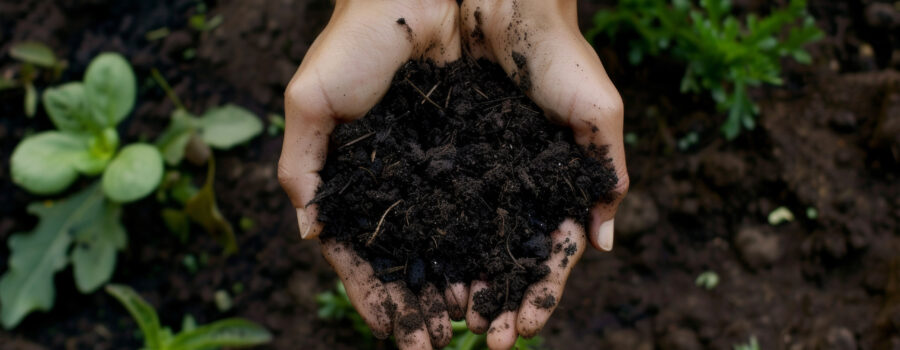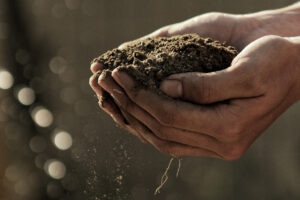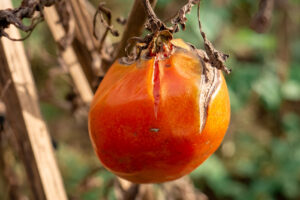I’m always looking for ways to streamline food forest development and maintenance. Initially, I kept compost bins at the back of our property in the outermost zones that I visited the least. I never turned the piles or maintained them in any way, only adding kitchen waste and yard trimmings once or twice a week. Eventually, the area began to look a bit unkempt, and when the empty lot next to ours sold and a new neighbor built a driveway next to the bins, I began to consider alternatives to a visible compost heap.
Hugelkultur promotes a fungal-dominated soil, which is ideal for perennials and food forests. Decomposing wood holds water like a sponge — something a compost pile can’t do for your garden directly — and hugelkultur beds decompose slowly over the years, feeding plants long-term. My favorite part is that it’s as low-input as any permaculture practitioner could desire. Just layer organic matter and let nature do its thing.
During winter pruning, I accumulate piles of unattractive biomass. I prefer keeping all the organic matter onsite, but I’m not crazy about a sloppy looking garden, so now I create a pile where I’d like a new planting and start a hugelkultur bed.
The History of Hugelkultur
Hugelkultur originated in Europe, where farmers searched for ways to enhance soil fertility and maximize yield in small spaces. German for “hill culture,” this raised-bed gardening system uses decomposing wood and organic matter to create nutrient-rich, moisture-retaining soil. It has been used for centuries to reduce the need for irrigation and increase garden productivity. Eventually, permaculture pioneers experimented with hugelkultur, integrating it into modern sustainable gardening.

How Hugelkultur Works
Hugelkultur mimics natural decomposition processes by layering wood, leaves, compost, and soil in a mound. As the wood decomposes, it releases nutrients into the soil, improves aeration, and increases moisture retention. The process also encourages beneficial microbial activity, resulting in a self-sustaining ecosystem that supports plant growth with minimal external inputs.
Benefits of Hugelkultur
One of my favorite aspects of Hugelkultur is how low maintenance it is! Just organise the pile and reap the benefits. In addition to the fact that they remain productive for years, the beds offer numerous environmental and practical advantages:
- Water Retention and Reduced Irrigation Needs
The buried logs and organic matter soak up rain and slowly release moisture to your plants during dry spells — reducing the need for irrigation during the hot season. - Soil Fertility
As the wood breaks down, it enriches the soil with essential nutrients, reducing the need for synthetic fertilizers and increasing microbial life. - Sustainable Waste Recycling
By repurposing logs, branches, and other organic waste, hügelkultur contributes to sustainable land management and reduces landfill waste. - Improved Drainage and Airflow
The raised mound allows excess water to drain off. The interior stays moist, while roots get access to both air and moisture. - Extended Growing Season (In cooler climates)
The decomposition process generates heat, which can help warm the soil, allowing for an extended growing season in colder climates.

Building a Hugelkultur Bed Step-by-Step
- Select a Location
Choose a well-drained site with adequate sunlight. Consider factors such as wind direction, slope, and accessibility when choosing the site for your hugelkultur bed. - Gather Materials
Collect logs, branches, twigs, leaves, grass clippings, compost, manure, and topsoil. DO NOT USE treated wood, walnut (which contains growth-inhibiting compounds), or diseased plant material. - Laying the Foundation
Dig a shallow trench (optional) to anchor the base logs. Arrange the largest logs at the bottom, stacking smaller branches and twigs on top. - Adding Organic Layers
Fill gaps with organic materials such as straw, compost, manure, and grass clippings. These elements accelerate decomposition and provide additional nutrients. - Covering with Soil
Spread a thick layer of topsoil over the mound, ensuring even coverage for planting. - Mulching and Planting
Apply a layer of mulch to conserve moisture and suppress weeds. Select plants based on the bed’s microclimates — drought-tolerant plants for the top, moisture-loving plants for the base.
Here in Florida, frequent storms result in a lot of plant debris. Year-round plant growth also produce lots of biomass. Hugelkultur can be a valuable part of a closed-loop system, where nothing is wasted and a nutrient bank that acts as a slow-release fertilizer. Here in North Central Florida, heavy summer rainfall can leach nutrients from soil, but a good hugelkultur mound can feed a guild for years. Plus, no expensive raised bed structure is required!

Most of you, as I did, will recognize a similar process to filling any raised bed without going broke by adding logs, sticks and trimmings at the bottom to take up space before adding compost and soil. These layers of decaying matter in various stages is nature’s answer to creating a fertile foundation for new growth — the old feeds the new in a beautiful circle of life.

Maintaining a Hugelkultur Bed
A well-constructed hugelkultur bed requires minimal maintenance. However, the following steps ensure long-term productivity:
- Regular Watering (Initial Phase)
During the first year, additional watering may be necessary until the bed establishes its moisture-retention capabilities. - Crop Rotation and Companion Planting
Rotating crops prevents nutrient depletion and reduces pest issues. Companion planting enhances biodiversity and soil health.
Curious about companion planting?
Return to the wisdom of polyculture…

PRODUCT TIP:
Gorilla Carts Heavy Duty Dump Wagon
One of my favorite gardening tools since 2020. Hauls heavy loads of mulch and soil, transports trimmings and weeds and lifts to dump the load (perfect for creating hugelkultur mounds). I’ve left mine out in all weather and it’s been a cost-effective work horse. I highly recommend this garden cart!
Potential Challenges and Solutions
While hugelkultur offers numerous benefits, some challenges may arise:
- Settling and Shrinking
Beds may shrink as wood decomposes. Adding organic matter like soil or mulch annually counteracts this issue. - Initial Nitrogen Lock-Up
In the initial stages, nitrogen may be temporarily bound as wood decomposes. Adding nitrogen-rich amendments, such as manure or leguminous cover crops, balances nutrient availability. - Takes Time to Mature
The bed improves over the years, but in the first season or two, it may not perform at peak levels. - Potential for Unwanted Fungi or Pests
Decomposing wood can attract fungi and insects. Avoid soft woods and aim to attract predators, such as birds or beneficial insects. Avoiding overly dense woody material can also help mitigate this problem.

An Investment in the Future
Hugelkultur beds evolve over time as the materials inside decompose. Here’s what to expect:
- Settling and Shrinking (First Few Years) The buried wood and organic matter start to break down, causing the bed to settle. You may need to add more soil or mulch on top if you want to maintain its height. Initial nitrogen drawdown can occur as microbes decompose the wood, temporarily reducing nitrogen availability for plants.
- Increased Soil Fertility (2-5 Years) As decomposition continues, the bed becomes rich in nutrients. The rotting wood acts like a sponge, retaining moisture and slowly releasing nutrients. Fungi and beneficial microorganisms thrive, improving soil structure and plant health.
- Maximum Productivity (5-10 Years) By this stage, the bed is fully mature, providing excellent soil aeration and fertility. The wood inside has partially decomposed into humus, creating a nutrient-dense growing environment. The bed remains self-sustaining with minimal irrigation and fertilization needs.
- Final Decomposition and Integration (10+ Years)
Most of the original wood will have broken down, leaving a rich, dark soil. The bed will have lowered significantly as the organic material turns into compost. At this point, it can be rebuilt by adding more logs and organic matter or used as a standard raised bed.
Over time, hugelkultur transitions from a structured mound into highly fertile, moisture-retentive soil, making it a long-term investment in soil health. Overall, it is a great investment in soil improvement, with a little upfront effort and patience it will soon reach its full potential.
Embrace the Efficiency
Hugelkultur offers a time-tested way to enhance soil fertility, improve moisture retention, and recycle organic waste. I recommend it to anyone who would prefer to avoid unsightly and high-maintenance compost piles. It will become the joy of any lazy (ahem, efficient) gardener!
Copyright © 2025 Fruitful Food Forestry & Lauren Lynch. No portion of the original content on this website may be reproduced, in any language, without express written consent.
Want to express your gardening philosophy?
Check out what we’re “petaling”…









Leave a Reply
Your email is safe with us.